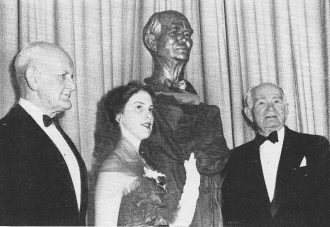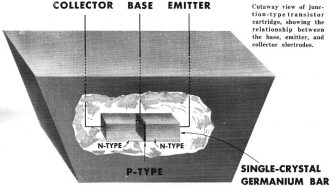The Future of the Transistor |
|
For many years, Radio-Electronics magazine editor Hugo Gernsback and Audion tube inventor Dr. Lee de Forest had sort of a mutual admiration society thing going on. that's understandable because they we both men of great accomplishment and are deserving of everyone's admiration. In this 1952 issue, Dr. de Forest was invited to procrastinate on future of the transistor - the semiconductor equivalent of his amplifying vacuum tube. He humbly states, "If in the year 1912 some editor had requested of me an article on the 'Future of the Electronic Tube,' I probably would have felt quite as incompetent and short-sighted a prophet of the developments of that [...], as I feel today as Mr. Gernsback requests from me an outlook over the future of the transistor, [the] possible successor of the grid tube." Less than four yeas had passed since the Bell Labs trio announced their transistor invention, but the technology advanced quickly once made known. History shows Dr. de Forest was correct in predicting the vacuum tube and transistor (in all their various forms) would coexist for a long time. It was not until the 1980s that solid state devices had replaced nearly all tubes (except the CRT display). Early semiconductors were limited to low powers and low frequencies, thereby required the continued use of vacuum tubes for traditional applications. Nowadays, though, semiconductors go far beyond the capabilities of tubes in every realm. The Future of the Transistor
By Lee de Forest If in the year 1912 some editor had requested of me an article on the "Future of the Electronic Tube," I probably would have felt quite as incompetent and short-sighted a prophet of the developments of that, my most outstanding invention, the grid amplifier and oscillator tube, as I feel today as Mr. Gernsback requests from me an outlook over the future of the transistor, that possible successor of the grid tube. Dr. de Forest's granddaughter, flanked by the inventor (right), and Admiral Ellery W. Stone, unveils the bust presented to Yale University by The de Forest Pioneers. In 1912 I had already accrued the benefit of six years experimentation with the electron tube, whereas today I have had little experience with these delightful little transistor midgets recently handed to me, ready made, by the Bell Laboratories. The transistor is as yet far too young a baby for even its most intimate engineering parents, under the astute guidance of Dr. William Shockley, to predict with absolute certainty its future possibilities, the degree or scope of its acceptance by the engineering and manufacturing professions, its unquestionable advantages, and its inherent limitations. When Admiral Ellery Stone, president of the All America Cables and Radio Corporation, recently informed me that his ever-progressive company was now estimating a proposed trans-Atlantic coaxial relay cable, similar to that which the A. T. & T. Co. recently laid between Key West and Havana, I remarked that of course his engineers would use transistors in place of the 22-year-life triode tubes now in the Havana cable for two important considerations: first, the great saving in electric current which the 30 or 40 cable-enclosed amplifier groups would demand (transistors vs. tubes); and second, that the life of the transistors would be eternal - the relays would never need replacement. To my amazement, Admiral Stone replied that as yet no one knows what is the useful life of the transistor! Later conversations with Dr. Shockley and other Bell Laboratories engineers confirmed this uncertainty as to the life endurance of the transistor, contact or junction types. The device is yet too young to afford positive knowledge regarding its useful life. Although one would naturally feel justified in assuming it to be eternal, it is actually "indefinite" today, for the reason that the transistor crystal is a synthetic compound, made up, in molten state, of germanium plus one or several other elements as impurities (gallium, arsenic, and others). It is conceivable, although apparently highly improbable, that a gradual dissemination or diffusion of the injected impurities which might in time occur would act to alter materially the initial amplifying characteristics of the presently preferred junction type of the transistor. It must be recognized that transistor development is today in a state of flux, being carried on independently in each of a substantial number of independent laboratories: Bell, RCA, Sylvania, Westinghouse, Hazeltine, and others, all operating under licenses from the Bell Laboratories' parent patents. The sum of all the knowledge and manufacturing know-how that is certain to result from all this intensive investigation ultimately may make appear quite rudimentary all that is known today regarding this amazing little triode, the transistor. For, after all, the transistor, like its predecessor, the Audion tube, is a triode. The two instrumentalities have this in common: both are triodes, three-electrode devices, and both amplify electronically - one using free electrons in vacuo or in gas, the other using electrons bound (not very tightly) to solid metal, where they can yet hop, skip, and slide about, like bunker marbles, from hole to hole. Obviously the prime basic advantage possessed by the transistor over the audion tube is its smallness. In bulk the transistor is less than one quarter that of the smallest sub-subminiature tube. Twenty of them could be packed within the envelope of a normal-sized miniature tube. This fact alone proves its great advantage in every case where amplifier space is an important item. Unquestionably the transistor will soon replace vacuum tubes in all hearing-aid devices, in all proximity fuses, in self-guiding missiles. Its indestructibility under terrific shock and impact indicates the absolute certainty of its employment in possible future warfare. Already the Western Electric Company is turning out a thousand contact-type transistors per day, all of which are at present for the U. S. Government. The cost is estimated - so I am informed - at more than $10.00 each, a figure which soon should be greatly reduced. In all types of calculating machines, regardless of its noise factor or any other shortcomings inherent in today's transistor (which are certain to be reduced or eliminated by the research now devoted to the problems) there are great advantages to be derived by its use, as against the shortcomings of the electron tube. Cutaway view of junction-type transistor cartridge, showing the relationship between the base, emitter, and collector electrodes. Where operations are enormously involved, communications by elaborate permutations and combinations of an on-off, yes-no, dot-dash, or 0-1 symbolism; the "flip-flop" circuits employing transistors offer the ideal in simplification. I have in mind especially that great marvel in electronic calculating and computing machines, the IBM selective-sequence electronic calculator, which now occupies three sides of a gigantic hall on Madison Avenue, New York City, and comprises among its labyrinthian circuits and relays 6,000 electron tubes, occupying a tube rack some 150 square feet in size. Barring the space required in the rear for the essential conductors, this tube area could now be reduced to one-fiftieth of the present required board area, with corresponding reduction in cathode heating requirements. A tremendously useful field for the transistor of the future will include every type of calculating machine, where compactness and durability of electron-operated components are desirable or essential features. Certain limitations on reduction of space requirements are imposed upon the designer of such apparatus in the future by the unavoidable space requirements of the electromagnets and the necessary cabling requirements. But in the realm of calculating machines the advantages of the transistor over the heretofore employed electron tubes are obvious. In the field of radio and television receivers, it is yet too early to speak with authority as to just how far the substitution of the solid-bound electron for the vacuum-free electron can be advantageously carried out. Unquestionably there will be such radical substitutions in many types of radio and television receiver and amplifier circuits. The day is coming when, by virtue of the small volume of the transistor units in miniature printed circuits, the dimensions of present television chassis will appear gigantic by comparison. The match-case radio receiver and the pocket-size television chassis will make possible radical price reductions. The recent banquet in New York, honoring Dr. Lee de Forest for his invention of i he three-element electron tube, was given by The de Forest Pioneers, a group of past and present associates of the noted inventor. In reporting the event in "The Radio Month" column of last month's Radio-Electronics, sponsorship was inadvertently attributed to The Radio Pioneers, another organization whose members have contributed notably to the development of modern electronics. We will still demand loudspeakers rather than head-telephone sets, and will demand kinescopes of ever enlarging dimensions-at least until the future "projector lens" popularizes the roll-down, roll-up, wide-angle viewing screen in the home. Would God that the cultural improvements in television programs were as certain as are the engineering improvements hereinabove visioned! After all is said of the transistor and its wide horizons of utility, it will be found that for certain purposes and employments the Audion tube will continue to maintain its present indispensability; and unquestionably the tetrode and pentode tube will continue to per-form circuital functions not so readily achieved by any type of triode, vacuous or solid-state. Especially will such considerations dictate circuiting designs where factors of larger voltage and grid-control are dominant. As yet we know very little regarding the power limitations of the solid-matter type of amplifier, having in mind also its frequency limits, defined to-day by the inverse capacitance limitations inherent to the transistor type of detector and amplifier. Certain it is, however, that this new type of triode amplifier, typified by the transistor and its kin (already discovered and soon to multiply) in today's new solid-state physics, is destined greatly to alter our heretofore-held concepts of the practical application of electronics to the multifarious projects to be faced by the engineer.
Posted April 15, 2022 |
|

 The "Father of radio" sees transistors and tubes
inseparable active partners
The "Father of radio" sees transistors and tubes
inseparable active partners 
